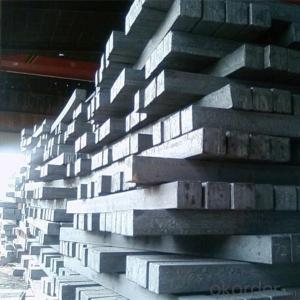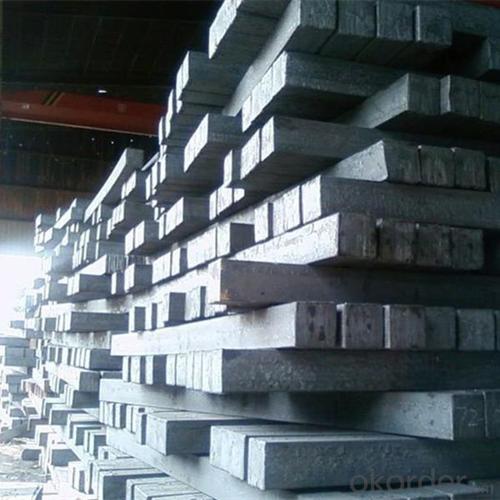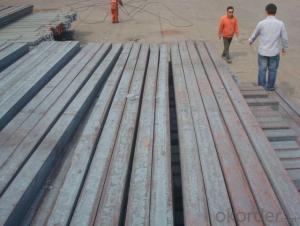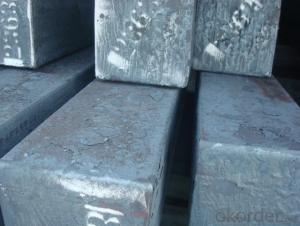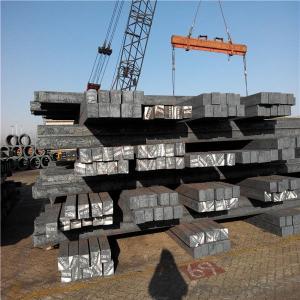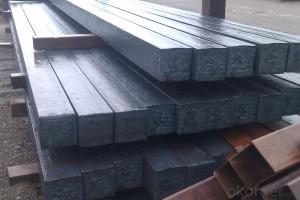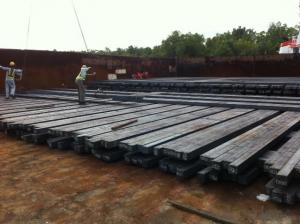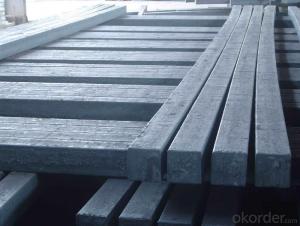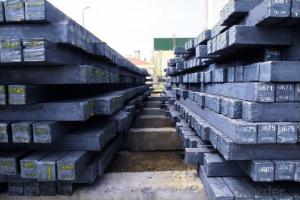2015 hot sale in China Q235 high quality Prime Steel billet
- Loading Port:
- China main port
- Payment Terms:
- TT OR LC
- Min Order Qty:
- 25 m.t.
- Supply Capability:
- 800000 m.t./month
OKorder Service Pledge
OKorder Financial Service
You Might Also Like
Quick Details
| Place of Origin: | Hebei, China (Mainland) | Brand Name: | CNBM | Model Number: | steel billets |
| Grade: | Q235,Q195,20MnSi etc. | Chemical Composition: | 2015 hot sale in China Q235,Q195, 20MnSi high quality Prime Steel bil | Shape: | Square, Square |
| Length: | 3-12m or as your request | Standard: | AISI, ASTM, BS, DIN, GB, JIS | Technique: | Hot Rolled |
| Dimensions: | 120-150 | Alloy Or Not: | Is Alloy | Secondary Or Not: | Non-secondary |
| Type: | prime quality steel billet | Quality: | Prime high quality | Application: | Wire rod , rod , deformed bars , profile steel etc. |
| Dimension: | 50mm-180mm or as your request | Price: | Competitive | Service: | Professional and good |
| Price terms: | CFR, CIF, FOB | Terms of payment: | L/C at sight or T/T | Delivery: | on time |
Packaging & Delivery
| Packaging Details: | standard packing for export |
| Delivery Detail: | within 25-45 days after receiving deposits or original LC |
2015 Hot Sale in China Q235 high quality Prime Steel billet , mild steel billet
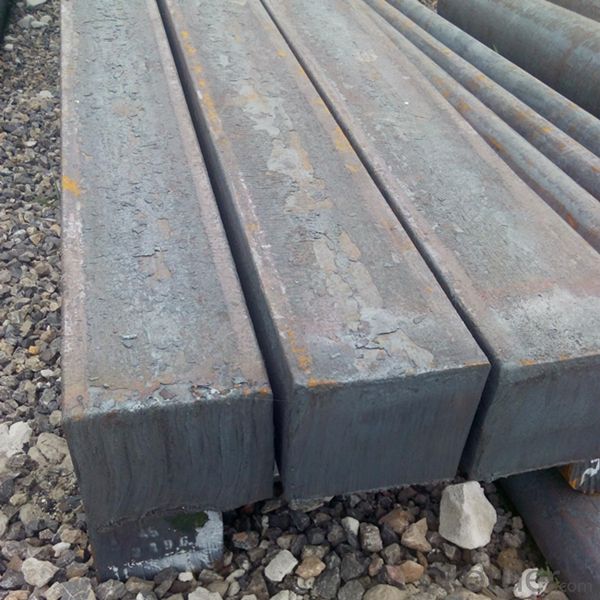
Specifications
1.Grade: Q195, Q235, 20MnSi etc.
2.Terms of payment: TT or L/C at sight etc.
3.Size: 120-150 or as your request
- Q: How do steel billets contribute to the manufacturing of marine gear?
- Steel billets contribute to the manufacturing of marine gear by serving as the raw material for the production of various components, such as gears, shafts, and bearings. These billets are first heated and then shaped through forging or machining processes to create the desired gear components with high strength and durability. The use of steel billets ensures that the marine gear can withstand the harsh conditions of marine environments, such as corrosion, high loads, and extreme temperatures, ultimately enhancing the performance and reliability of the gear in marine applications.
- Q: What are the main challenges in the recycling of steel billets?
- One of the main challenges in the recycling of steel billets is the presence of impurities and contaminants that need to be removed in order to produce high-quality recycled steel. Another challenge is the need for efficient sorting and separation techniques to properly categorize and process different types of steel billets. Additionally, the energy-intensive nature of the steel recycling process poses a challenge in terms of reducing carbon emissions and achieving sustainability goals.
- Q: The role of carbon content in steels
- Carbon is the main alloying element of iron and steel, so steel is also called iron carbon alloy. The main role of carbon in steel is to:1., the formation of solid solution tissue, improve the strength of steel, such as ferrite and austenitic structure, are dissolved in carbon;
- Q: How are steel billets used in the manufacturing of valves and pumps?
- Valves and pumps require steel billets, which are necessary raw materials in their manufacturing process. These billets are cast into specific shapes, typically squares or rectangles, and serve as the foundation for producing valves and pumps. To make valves, steel billets are first heated and then forged or rolled into the desired shape. The billets undergo various processes like cutting, drilling, and machining to create different valve components, including the body, bonnet, disc, stem, and seat. These components are then assembled to form the valve, which controls the flow of fluids or gases in a system. Similarly, in pump manufacturing, steel billets are heated and shaped to create essential parts such as impellers, casings, shafts, and housings. These parts are then assembled to construct a pump, responsible for transferring fluids or gases from one location to another. The use of steel billets in valve and pump manufacturing is crucial due to steel's inherent properties. Steel is highly valued for its strength, durability, and resistance to corrosion, making it ideal for applications in industries where valves and pumps face high pressures, temperatures, and corrosive environments. Moreover, steel's versatility allows manufacturers to customize valves and pumps in terms of size, shape, and specifications to meet the specific requirements of diverse industries and applications. This adaptability ensures that valves and pumps made from steel billets can perform reliably and efficiently in various environments and conditions. In conclusion, steel billets play a vital role in the manufacturing of valves and pumps. Through forging, shaping, and assembly processes, steel billets are transformed into essential components that constitute these crucial industrial devices. The use of steel guarantees the strength, durability, and corrosion resistance needed for valves and pumps to function effectively and endure demanding operational conditions.
- Q: What are the potential applications of steel billets in the oil and gas sector?
- Due to their excellent mechanical properties and durability, steel billets offer a wide range of potential applications in the oil and gas sector. Here are several examples: 1. Drill pipes and casings: Manufacturing drill pipes and casings, which are vital components in the drilling process, can be achieved using steel billets. These pipes and casings must endure high pressure and extreme temperatures, necessitating the strength and toughness provided by steel billets. 2. Pipelines: Steel billets can be utilized to create seamless or welded steel pipes for oil and gas pipelines. These pipes are responsible for transporting oil, gas, and other petroleum products across long distances. Steel billets ensure the durability and integrity of the pipelines, withstanding high pressure, corrosion, and impact. 3. Offshore structures: Steel billets are also essential in constructing offshore platforms, drilling rigs, and other structures used in extracting and producing oil and gas from offshore reserves. These structures are exposed to harsh marine conditions, including saltwater, wind, and waves. Steel billets provide the necessary strength and corrosion resistance to withstand these challenging environments. 4. Pressure vessels and storage tanks: Steel billets can be employed in manufacturing pressure vessels and storage tanks used for storing and transporting oil, gas, and various chemicals. These vessels and tanks must withstand high pressure and temperature variations without compromising safety. Steel billets offer the required strength and resistance to corrosion and leakage. 5. Equipment components: Steel billets are also used in fabricating various components and equipment used in the oil and gas sector, such as valves, flanges, fittings, and connectors. These components are crucial for the operation and maintenance of oil and gas facilities, and steel billets ensure their reliability and performance. In conclusion, the potential applications of steel billets in the oil and gas sector are extensive and diverse, covering various stages of exploration, production, transportation, and storage. Their exceptional strength, durability, and resistance to extreme conditions make them an ideal material choice for critical applications in this industry.
- Q: Are steel billets used in the production of musical instruments?
- Yes, steel billets are commonly used in the production of musical instruments. They are often used to create various components such as keys, valves, and rods, which are essential parts of instruments like saxophones, trumpets, and trombones.
- Q: How do steel billets contribute to the chemical industry?
- Steel billets are a crucial raw material in the chemical industry as they are used in the production of various chemical equipment and machinery. These billets serve as a foundation for manufacturing components such as pipes, valves, tanks, and reactors, which are essential in carrying out chemical processes. Their strength, durability, and resistance to high temperatures make steel billets an ideal choice for constructing reliable and safe equipment used in the chemical industry.
- Q: What are the different shapes and sizes of steel billets?
- Steel billets come in a variety of shapes and sizes, depending on their intended use and the manufacturing process. The most common shapes of steel billets include square, rectangular, and round. Square billets are typically used for forging and rolling processes, where they are heated and shaped into various products such as bars, rods, and rails. These billets have equal dimensions on all sides, forming a square shape. Rectangular billets, on the other hand, have longer sides and shorter ends, resembling a rectangular shape. These billets are commonly used in the production of structural components, like beams and columns, as well as for making pipes and tubes. Round billets, as the name suggests, have a cylindrical shape and are often used in the manufacturing of seamless pipes, axles, and shafts. Due to their uniform circular cross-section, they are well-suited for processes that involve rotary motion or require a strong cylindrical shape. In terms of sizes, steel billets can vary greatly depending on the specific requirements of the final product. Their dimensions are determined by factors such as the desired end product, the manufacturing process, and the available equipment. Common sizes range from small billets, typically measuring around 100mm to 200mm in diameter or width, to larger billets that can exceed 300mm in diameter or width. It is important to note that steel billets can also be customized to meet specific size and shape requirements of different industries. This flexibility allows for the production of a wide range of steel products, catering to diverse applications in construction, automotive, and other manufacturing sectors.
- Q: What are the main disadvantages of using steel billets?
- Using steel billets in various industries comes with several disadvantages. To begin with, one major drawback of steel billets is their high cost. The manufacturing process of steel billets is complex, involving the melting and casting of steel, which can be quite expensive. Consequently, this cost is then passed on to the end product, making it less affordable for consumers. Moreover, steel billets tend to be heavy and bulky, making transportation and handling challenging. The weight and size of steel billets contribute to logistical difficulties in the supply chain, leading to increased costs and potential delays. Another disadvantage is the limited availability of steel billets. Steel production requires a substantial amount of resources and energy, and the availability of raw materials can be restricted, resulting in potential disruptions in the supply chain. This scarcity can have a negative impact on industries heavily reliant on steel billets for their operations. Furthermore, steel billets have limited shape flexibility. They are typically produced in standardized sizes and shapes, making customization for specific design requirements difficult. This lack of flexibility can be a significant drawback for industries that necessitate intricate and unique shapes for their products. Moreover, steel billets are susceptible to corrosion if not properly treated. Exposure to moisture and certain environments can lead to rust and degradation, reducing the lifespan and durability of products made from steel billets. Regular maintenance and anti-corrosion treatments are essential to mitigate this disadvantage. Lastly, the production of steel billets has a significant environmental impact. The manufacturing process emits greenhouse gases and consumes substantial amounts of energy and water. These environmental concerns have resulted in increased scrutiny and regulations on steel production, thereby adding extra costs and complexities to the use of steel billets. In conclusion, while steel billets offer advantages in terms of strength and durability, they also come with several drawbacks. These include high costs, transportation challenges, limited availability, lack of shape flexibility, susceptibility to corrosion, and environmental impact. Industries must carefully consider these disadvantages when evaluating the use of steel billets in their operations.
- Q: How do steel billets contribute to the overall safety of a structure?
- A structure's overall safety is greatly influenced by steel billets in several ways. To begin with, steel billets act as the raw material for producing steel bars, beams, columns, and other structural components. These components are widely utilized in construction due to their exceptional strength and durability. By utilizing steel billets as the starting material, the resulting steel products display outstanding load-bearing capacity, thereby bolstering the structural integrity of the building. Furthermore, steel billets undergo a rigorous manufacturing process that encompasses various quality control assessments. These assessments ensure that the billets possess consistent and dependable mechanical properties, such as high tensile strength and impact resistance. Consequently, when these billets are employed in constructing a structure, they contribute to its overall safety by providing a dependable and robust framework capable of withstanding external forces like wind, earthquakes, or heavy loads. Additionally, advanced metallurgical techniques, such as controlled cooling or heat treatment, are frequently employed to produce steel billets with specific properties required for structural applications. These processes aid in enhancing the steel's microstructure, reducing internal defects, and improving its resistance to corrosion, fatigue, and other forms of degradation. In turn, this prolongs the structure's lifespan and minimizes the risk of structural failure, ensuring the safety of its occupants. Moreover, steel billets can be manufactured with precise dimensions and tolerances, permitting accurate and efficient construction. This precision in fabrication ensures that structural components fit together seamlessly, reducing the likelihood of gaps, misalignments, or weak points that could compromise the structure's safety. Lastly, steel billets are highly recyclable, making them an environmentally friendly choice for construction. By opting for steel billets, the construction industry can diminish its carbon footprint and contribute to sustainable development. This focus on sustainability aligns with the structure's overall safety, as a sustainable approach guarantees the long-term stability and resilience of the built environment. In conclusion, steel billets enhance the overall safety of a structure by providing construction materials that are strong, durable, and reliable. Their consistent mechanical properties, resistance to external forces, improved microstructure, and precise fabrication ensure a sturdy and secure framework. Additionally, their recyclability promotes sustainability, further enhancing the structure's long-term safety and integrity.
Send your message to us
2015 hot sale in China Q235 high quality Prime Steel billet
- Loading Port:
- China main port
- Payment Terms:
- TT OR LC
- Min Order Qty:
- 25 m.t.
- Supply Capability:
- 800000 m.t./month
OKorder Service Pledge
OKorder Financial Service
Similar products
Hot products
Hot Searches
Related keywords
